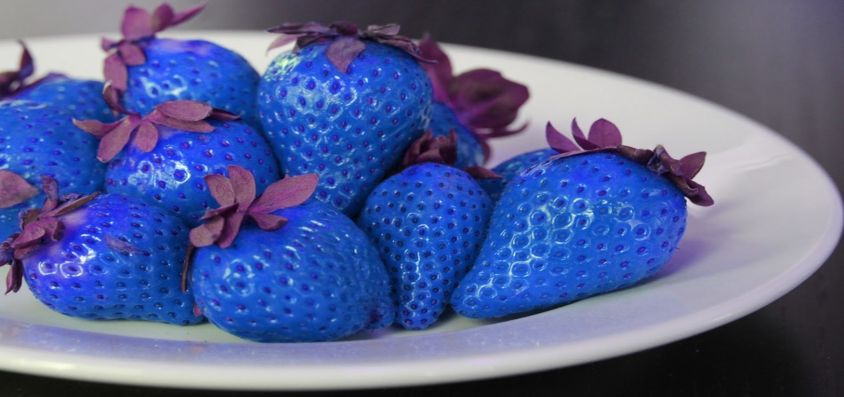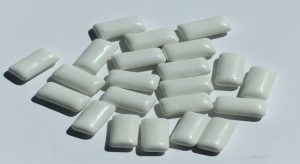Some studies have shown that the colour blue can have appetite-suppressing effects.
There are, however, no robust scientific studies that can explain clearly how the colour blue can impact a person’s desire to eat.
Therefore, we don’t know how exactly the colour blue might curb one’s appetite.
That said, researchers who examined the impact of food colour on appetite have some theories on why blue may instinctively suppress appetite or cause aversion to food.
According to one theory; since there is almost no blue food in nature, the human brain doesn’t have an automatic appetite response to blue. In other words, the human brain doesn’t associate the colour blue with hunger or food.
Overview
Anecdotal evidence and existing research — although not enough to draw a certain conclusion — tell us that blue may suppress one’s appetite.
It is important to note that the appetite-suppressing effects of blue might not be limited to the food itself.
According to recent studies; the colour blue used in the dining area may curb a person’s appetite [1, 2].
This might be the reason why nowadays many weight loss programs suggest using blue plates, trays, and if possible blue lights in the dining area.
There are even some blue-tinted sunglasses on the market, which are claimed to help people eat less if they wear them while eating.
In the rest of the article, we will try to explore the psychology behind how and why the colour blue might impact one’s appetite.
Colour Psychology
Science tells us that colours can impact many physiological and psychological processes; such as creativity, learning, sleep quality, thinking, mood, appetite, body temperature and heart rate [3, 4, 5, 6, 7].
In fact, this is a research area known as colour psychology, which examines the impacts of colours on human physiology and psychology.
Here is an example of how colours might affect us…
As of 2000, some major railway operators in Japan started installing blue lights on railway lines with the aim of reducing the incidence of suicide.
The data collected over 13 years showed that the number of suicide decreased by 74% at the stations where the blue lights were installed [8, 9, 10].
Since it is thought and in some cases proven that colours can affect people’s decisions, moods or thinking; many companies around the world attach particular importance to choosing the right colours for their products, logos, offices and restaurants.
For instance; many pharmaceutical companies, medical businesses and financial companies use blue in their logos and designs supposedly because blue represents calmness, serenity, stability, reliability and trust [11, 12].
Major fast-food chains are another great example…
The claim is many fast-food chains use yellow and red colours in their logos and restaurants to subtly influence customer behaviours. Red is suggested to stimulate appetite and give a sense of urgency while yellow is associated with happiness and friendliness [5, 13].
Obviously, most fast-food chains and restaurants avoid using blue in their logos, food packages and restaurant designs.
This may be indicating that blue is considered an appetite suppressant and thus most restaurants and fast-food companies avoid using hues of blue.
Studies on Blue and Appetite
In a 2015 study; researchers aimed to determine whether the colours of lighting can influence the amount of food consumed.
112 participants were asked to consume a breakfast meal under three different lighting colours: white, yellow, and blue.
The results revealed that the blue lighting significantly decreased the amount of food consumed by men, but not by women, compared to other lighting colours.
In a Japanese study; researchers aimed to investigate whether the colours of hot soup can affect food acceptability, appetite and body temperature.
Participants consumed one day white (original colour of the soup), another day yellow (modified colour) and the other day blue (modified colour) hot soup at 9 am every morning on 3 separate days.
The results revealed that blue soup significantly decreased willingness to eat, palatability, pleasantness compared to white and yellow soups.
In a more recent study (2020); female participants were presented with some images showing differently coloured sweet foods (original colour, blue, red, colourless and black-and-white).
The participants were also shown images displaying the same type of sweet foods in their original colour but this time on different background colours (blue, red, white, and grey ).
All coloured sweet foods, but especially red and blue, were rated as less appealing than the original food images.
Here is an experiment “claimed” to be carried out in 1973:
A group of people were served a meal containing steak, chips, and peas under a special light that was showing the foods that they were eating, but not the colours of the foods.
Partway through the meal, normal lighting was turned on and diners realised that the steak they were eating was in fact blue, the chips green, and the peas red. Supposedly, most of them went sick after that realisation.
Note: As per some researchers; this experiment may have never taken place [14, 15].
As mentioned above, there are also studies that suggest that using the colour blue in the dining area such as on the walls, plates or trays may help people eat less [1,].
Lastly, in an experiment, sushi that was coloured blue, was found to lower the participants’ appetite.
Why Might Blue Suppress One’s Appetite?
As mentioned earlier, researchers have some theories that could explain why blue may suppress one’s appetite.
Here are the common, and arguably the most plausible, theories on why blue might impact a person’s desire to eat.
Natural Blue Foods Are So Rare
As mentioned at the beginning of the article; naturally blue foods are quite rare.
We can hardly count any of them other than blueberries and Damson plums. In contrast, there are plenty of orange, yellow and red foods that we consume regularly.
As such, researchers hypothesise that the human brain doesn’t have an automatic appetite response to blue; and, blue may even cause an aversion to the food [14, 16].
To put it simply, we human beings are not accustomed to eating natural blue foods. So blue, in and around food, may curb our appetite.
Blue May Have Calming Effects
It is believed that the colour blue can help decrease heart rate and slows down metabolism and thus may curb a person’s appetite.
There are scientific studies showing that blue can have a calming effect on the human body [8, 17, 18, 19, 20].
Nevertheless, more research is necessary to fully understand how blue slows down metabolism, lowers blood pressure and thus helps suppress appetite.
We Might Innately Avoid Blue Foods
Another theory is; we modern people instinctively avoid blue and black in foods because these colours were the signs of poisonous foods when our ancestors were foraging foods in nature thousands of years ago.
It is believed that the instinct of avoiding these colours, especially blue, in foods might be still with us.
Moreover, in general; toxic, and spoiled foods often look blue and black (for instance; mould/mold).
Final Verdict
It’s difficult to conclusively say blue, in and around food, suppresses appetite as there are no major studies on this topic.
Besides, it is a quite subjective issue, and each person can react differently to different colours.
There are, however, certain facts about blue foods. At least in the western diet, there is almost no natural food with blue colour.
Tomorrow, look at your breakfast meal or lunch and try to see any natural blue food on the table. You most likely won’t see any.
That is to say, we aren’t accustomed to consuming foods that are naturally blue. And, that might be the reason why the colour blue doesn’t trigger appetite response.
It bears repeating, major studies are needed to conclude whether, and if so how, blue suppresses a person’s appetite.
Until more robust scientific studies appear, our verdict is that the colour blue in and around food “may” suppress your appetite, however, to what extent, we may never know.
Tarkan is an experienced health writer ( currently more than 600 articles ) and also the founder of this website namely www.neededforhealth.com. His expertise in health stems from in-depth medical research and knowledge which he obtained over the course of many years.
Tarkan enjoys sharing factual knowledge on health, psychology and nutrition. He always aims to deliver evidence-based recommendations, provide links to related scientific studies.


